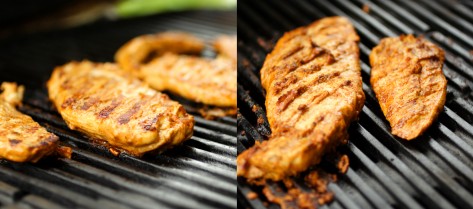Prince Pilpelchuma’s Hot Chicken

There is no Prince Pilpelchuma, at least not as far as I know. (Any resemblance to an actual person, living or dead, is entirely coincidental.)
Though fictional, Prince Pilpelchuma’s name is taken from two very real foods: a fiery hot condiment called pilpelchuma, a recipe for which can be found in the cookbook Jerusalem by Yotam Ottolenghi and Sami Tamimi; and hot chicken, a type of spicy fried chicken found in Nashville, Tennessee. This local specialty was made famous (and purportedly created) by Prince’s Hot Chicken Shack, a mecca of hot chicken set in a strip mall on the outskirts of town. (Hot chicken is so popular in Nashville that there is a festival devoted to the stuff.)
I’ve experienced pilpelchuma first-hand, initially straight up on the tip of my tongue to gauge its chile heat. Perhaps a crazy thing to do considering that Ottolenghi and Tamimi’s recipe contains 4½ tablespoons of cayenne pepper. But how else can you know what you’re dealing with if you don’t taste it?
As my tongue wondered what it had done to deserve such pain, I immediately thought of the hot chicken at Prince’s Hot Chicken Shack. Unlike pilpelchuma, I’ve experienced Prince’s Hot Chicken Shack second-hand, vicariously through the superior writing of David Ramsey. In his personal and humorous story about Prince’s, called “Some Like it Extra Hot” (Oxford American, Spring 2005: 94−101), Ramsey creates a memorable account of the people who make and eat the chicken, and of the chicken itself. It’s a testament to his writing that this place and its chicken have lodged themselves in my imagination. (So much so that I’ve written about Prince’s Hot Chicken Shack previously in another posting, here.)
One day I’ll go to Prince’s Hot Chicken Shack and experience hot chicken first-hand. Today, however, I’m going to make Prince Pilpelchuma’s Hot Chicken, which, except for the use of the main ingredient and an excessive use of cayenne pepper, bares no resemblance to the local Nashville specialty. But Prince Pilpelchuma doesn’t care. He likes his grilled, yogurt-and-pilpelchuma marinated chicken breasts just fine.
Serves 4
2 boneless chicken breasts (about 1½ pounds total)
Juice of ½ lemon
1 teaspoon salt
½ cup plain Greek yogurt, preferably whole-milk, plus more for serving
1 to 6 tablespoons pilpelchuma (recipe in the cookbook Jerusalem), according to taste (see Chile-odometer, below)
Four slices white bread
Butter for the bread (optional)
- Remove the skin from the chicken and trim away any fat. Pound the chicken until it is 3/8-inch thick.
- Place the chicken on a nonreactive platter. Drizzle with half of the lemon juice and sprinkle with ½ teaspoon of the salt. Flip the chicken pieces over and drizzle on the remaining lemon juice and sprinkle on the remaining ½ teaspoon of salt. Let sit for 15 minutes, turning once.
- In a small bowl, whisk together the yogurt and pilpelchuma. Transfer the marinade to a large zip lock bag. Add the chicken pieces and turn until completely coated with the marinade. Place in the refrigerator and marinate for at least 4 hours or overnight (the longer it sits, the hotter it will get). About 30 minutes before you’re ready to grill, remove the chicken from the refrigerator.
- Preheat the grill to high. Just before you’re ready to grill the chicken, oil the grate. Grill the large pieces of chicken breast for 4 minutes on each side, smaller pieces for 3 minutes on each side, with the grill cover closed. (Very small chicken tenders need only about 2½ minutes on each side.)
- Butter and grill the bread, if desired. Otherwise, serve the bread straight up out of the bag like they do at Prince’s Hot Chicken Shack. Place a piece of bread on each plate and top with the grilled chicken. To help manage the heat, alternate bites of the spicy chicken with plain yogurt and quench your thirst with cold milk. This is not the time to reach for a cold beer, not matter how tempting.
Chile-odometer
There are four levels of heat at Prince’s: Mild, Medium, Hot, and Extra Hot. In his story on Prince’s, David Ramsey describes them so: “The Mild is orange and plenty spicy, what most restaurants would label “hot.” The Medium is dark red and even more sizzling, what most folks would label ‘unreasonable.’ Ordering anything above that will earn you a stern warning from the staff if you’re a newcomer . . . .”
Prince Pilpelchuma’s hot chicken is off the charts vis-à-vis Prince’s hot chicken, but on the mild end of the chile-odometer. One tablespoon of pilpelchuma will create a pleasant tingle of heat, two tablespoons has a decided kick, and three to four tablespoons would be considered quite hot for most. (I personally like 3 or 4 tablespoons and I imagine that it is probably comparable to Prince’s Mild.) If you like a challenge, use 5 or 6 tablespoons of pilpelchuma. This amount perhaps approaches Prince’s Medium. The best thing about pilpelchuma is it’s not a one-dimensional, frat-boy heat: Even when using 5 or 6 tablespoons of the paste, your chicken, while fiery, will still be flavorful.
If you want to experience a Prince’s style, blow-your-head-off heat level, use more than 6 tablespoons of pilpelchuma. (How much more, I cannot say. This is unchartered territory. Proceed at your own risk of burning lips and tongue.) If you have little tolerance for spicy food, start with ½ tablespoon of pilpelchuma and work your way up.
Note to the griller: If you go with 3 or more tablespoons of pilpelchuma, make sure you’re standing downwind of the grill when you place the chicken on the hot grate. Otherwise you might find yourself in a coughing fit from inhaling chile pepper.

The more pilpelchuma you add to the marinade, the darker the color of the chicken. The chicken on the left was made using 3 Tbsp. of pilpelchuma, the chicken on the left, 6 Tbsp.
